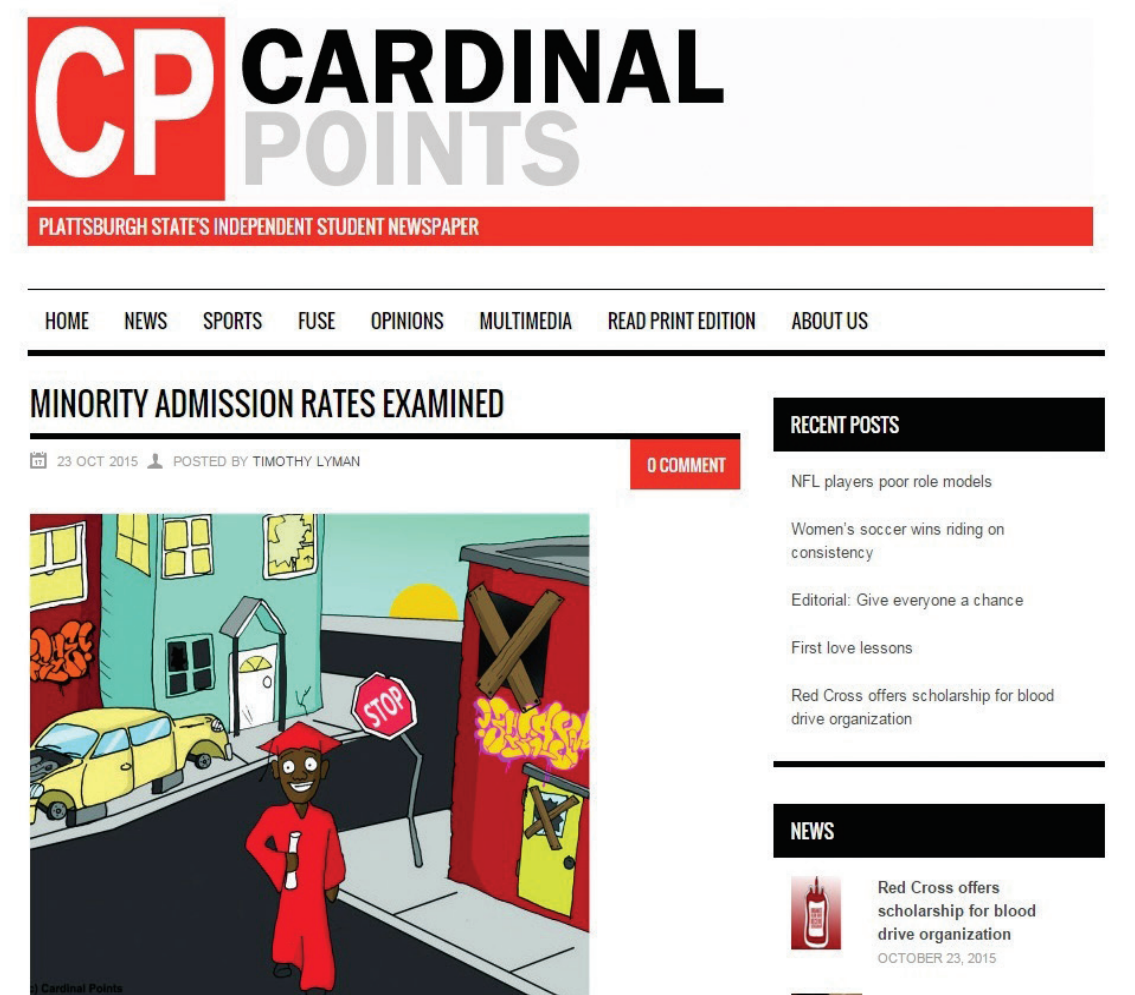A cartoon published in the SUNY Plattsburgh student newspaper has acted as the catalyst for teachers and students to discuss racial stereotypes at St. Lawrence University. It shows an African-American male walking through an economically challenged neighborhood. Stereotypes harm the way a person is perceived, but is there a politically correct way to depict minorities in virtual media? “He looks worried, wide-eyed, and surprised, as he’s standing at the corner of a dilapidated rundown neighborhood,” says Visiting Assistant Professor Naomi Falk. Falk, an art professor, says the neighborhood does not represent where African-Americans come from. “It’s not trying to be harmful, but images like this are often insidious,” says Falk.
“It perpetuates some really ugly stereotypes,” says Evelyn Powell Jennings, a history professor at St. Lawrence University. Jennings said that the portrayal of the character is not as problematic, because he’s smiling. It’s the setting that’s the issue. “To assume that all African-Americans come from broken down, economically challenged neighborhoods is wrong,” says Jennings.
Jennings says racial stereotypes are often perpetuated without explicit intent to harm minorities. She recalled an incident where a Latino student visited a local fast food restaurant. The student was complemented on her ability to speak clearly, insinuating that most Latin Americans are not proficient in the English language.
When presented with the image, Mehretab Abye Assefe, a visiting professor of sociology, posed a series of analytical questions. “What’s wrong with this? Is it the graffiti? The broken down windows? Frankly, I can’t think of any picture that would be right,” he commented. Assefa says the debates about these racial issues are usually between white elites who argue over how to correctly depict racial minorities.
He added that in, their efforts to create a politically correct image, these elites are only creating inaccurate representations of racial minorities. “It’s the setting that’s problematic,” says Anabel Encarnacion, the house coordinator of La Casa Latina. “I understand why it’s being portrayed that way, but it’s not like that. The artist has boiled down something that occurs on a huge scale into a little four-byfour box. You can’t do something like that,” says Encarnacion. She agrees that the cartoon is politically incorrect, but some of the themes depicted in the picture are correct. “I think it’s funny… a black face cartoon in what’s supposed to be the hood,” says Allanah Roopchand, a member of La Casa Latina. The conversation about race, writ large, often ends up being accusatory. It makes people defensive, and they seek to justify their mistakes instead of learning from them. Roopchand says that the conversation about race is often too aggressive. Encarnacion and Roopchand have both experienced discrimination on campus because of their race. In one instance, the two were declined aid from St. Lawrence security after a chaotic night. “They told us they couldn’t help us because they thought we went to SUNY Canton,” said Encarnacion.
Race is a difficult subject to discuss, and negative stereotypes based on race affect the people they generalize every day. These stereotypes manifest themselves covertly, for instance, when a white female crosses the street to avoid an interaction with a black male, or overtly, like when the members of the Lambda Theta Delta fraternity at University of California, Irvine posted a video of their members in blackface. There’s a lot of work to be done to overcome race related issues, and though controversial, cartoons like the one published in the SUNY Plattsburgh student newspaper are important in sparking an open, honest dialogue about a deeply troubling issue.



